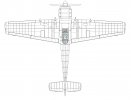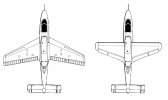Track grew from ~2m with the 'normal' Bf 109, to 2.5m with the 109X due to the new, wider fuselage as dictated by a wider engine (it also allowed for a bigger fuel tank now, 485L vs. 400).
Worth taking a look.
Compare with Spitfire, 1.74 m (68.5 in), including the Mk.XIV with 2200 HP Griffon; jumped to 1.96m (77in) with the late/post war 20 series and 40 series Seafires and their new wing.
FWIW
added: seems like the reason of the late Spits having wider track was due to the more slant angle of the struts, at least going on
by this
Germany was ill able to produce the BMW 801s for their needs, so something got to go; Fw 190 was a superior 'platform' anyway.
Even going just with 'normal' radiator gives a fighter that is as fast at least as the MC.202 for 1939-40, or that is faster than Bf 109E by some 30-40 km/h; what is more important is that Spitfire is no longer the fastest fighter in 1939-40. Speed differential vs. Hurricane and most of French fighters is huge.
Not having the cooling system that took the best part of internal volume allows for installation of more fuel - couple that with better streamlining and the fighter is also much more rangy than the 109E.


